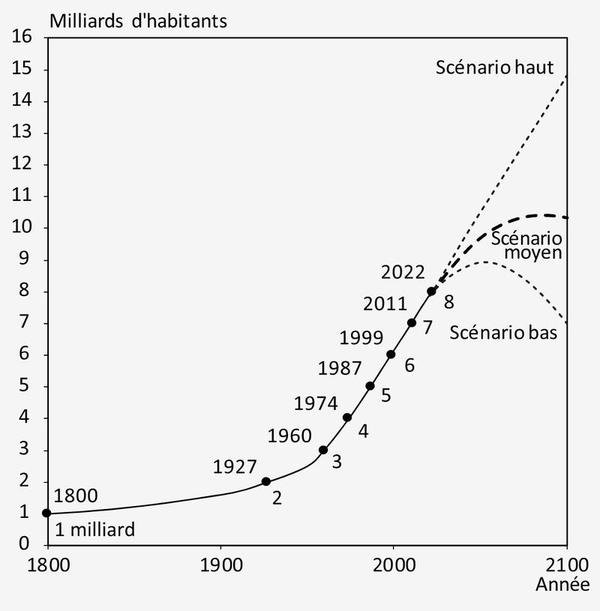
In 1800, the world's human population was estimated at about 900 million inhabitants. Two centuries later, in 2020, it exceeded 7.8 billion. This dizzying growth is the result of an exponential dynamic fueled by medical, agricultural, and technological progress. This growth is modeled by the equation: \[ N(t) = N_0 \cdot e^{r t} \] where \( N(t) \) is the population at time \( t \), \( N_0 \) is the initial population, and \( r \) is the average growth rate. Until the beginning of the 21st century, the parameter \( r \) reached values close to \( 0.02 \), or a growth of 2% per year. This evolution is explained by a strong reduction in mortality without an initial decrease in birth rates—a characteristic desynchronization of phase 2 of the demographic transition.
United Nations projections indicate that the world population could reach a peak of about 10.4 billion individuals by 2080, before stabilizing or declining slightly. This leveling off is explained by global demographic convergence: most countries are experiencing or will experience a drop in fertility below the replacement level (\( \sim 2.1 \) children/woman). From this point on, natural growth becomes negative, unless compensated by migratory flows or pro-natalist policies.
This asymptotic dynamic reflects the depletion of resources, water stress, growing inequalities, and negative feedback related to climate change.
From a spatial point of view, 21st-century population growth is highly polarized. Nearly 80% of the increase by 2100 will be concentrated in Sub-Saharan Africa. In contrast, many regions (Europe, East Asia) will experience a decline. This heterogeneity creates strong geopolitical, economic, and migratory tensions.
Furthermore, the global demographic transition is accompanied by rapid aging: the proportion of people over 65 could reach 25% by 2100, profoundly modifying economic balances and social models. This corresponds to a transition of the demographic system towards a new dynamic attractor, where biological entropy increases to the detriment of global reproductive potential.
| Continent | Estimated Population (2025) | Share of World Population | Annual Growth (%/year) |
|---|---|---|---|
| Asia | 4,790,000,000 | 59.3% | +0.6% |
| Africa | 1,490,000,000 | 18.4% | +2.4% |
| Europe | 740,000,000 | 9.2% | −0.1% |
| Latin America and the Caribbean | 670,000,000 | 8.3% | +0.6% |
| North America | 380,000,000 | 4.7% | +0.4% |
| Oceania | 46,000,000 | 0.6% | +1.2% |
| World Total | 8,120,000,000 | 100% | +0.9% |
N.B.:
The figures are deliberately rounded to the nearest million.
World population growth from 1800 to 2100 illustrates the behavior of an open living system: a phase of rapid growth under external energy and technological input, followed by saturation and bifurcation towards a new steady state, or even decline. Future balances will depend on many coupled parameters: education, public policies, climate, reproductive technologies, and inequalities.